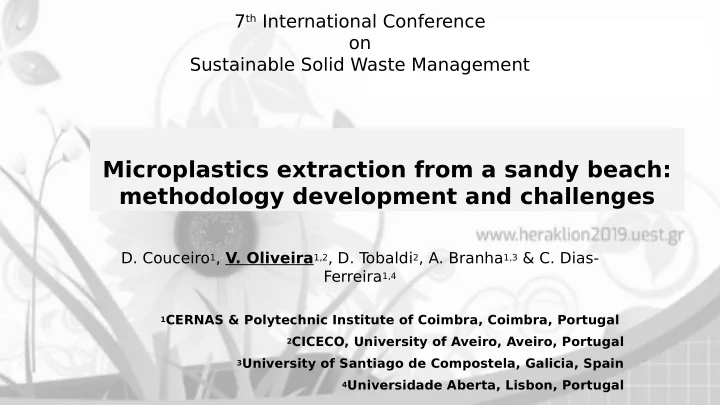

7 th International Conference on Sustainable Solid Waste Management Microplastics extraction from a sandy beach: methodology development and challenges D. Couceiro 1 , V. Oliveira 1,2 , D. T obaldi 2 , A. Branha 1,3 & C. Dias- Ferreira 1,4 1 CERNAS & Polytechnic Institute of Coimbra, Coimbra, Portugal 2 CICECO, University of Aveiro, Aveiro, Portugal 3 University of Santiago de Compostela, Galicia, Spain 4 Universidade Aberta, Lisbon, Portugal
Worldwide plastic production China is the largest producer of plastics 2016 2017 Asia 60 64.4 Europe 50.1 CIS million t million t 18.5% % NAFT 2.6% 335 348 A 29.4% Latin million million 17.7 China Ameri 3.9% Japan WORL t t % ca 16.8% Rest 2017 2016 Middl of Asia 4% Source: PlasticEurope, D e 2018 East, Africa World plastic production almost reached 7.1% Source: PlasticEurope, 350 M t 2018 2
Microplastics • Small plastic pieces smaller than 5 mm in size • Majority of items in the contaminated aquatic ecosystems • Spherical beads, fjlms, irregular fragments, fjlaments, foam, granules and fjbres • Poses a threat to aquatic life: sorbent of toxic pollutants like HM or PCBs persistent bioaccumulation Entering the food chain by ingestion by marine species 3
Microplastics • The Marine Strategy Framework Directive was amended to highlight that the “composition of micro-particles (in particular microplastics) has to be characterized in marine litter and the marine coastal environment”. • There are still no harmonised analytical methods for quantifying and determining the occurrence and composition of microplastics in those environments. 4
Objectives 1 - Development of an extraction technique for separating microplastics ( PP , LDPE, PS, PET and PVC ) from a sandy beach by using routine laboratory equipment - using the principle of fmotation and decantation process to promote the separation 2 - Assessment of the recovery effjciency of the proposed method for: i) each microplastic material ii) microplastics fractions by size 5
Preparation of microplastics samples Cutting Groundin Sieving (≈3 cm g (2, 1, 0.5, 0.2 and 0.05 size) in a mill mm) P PS PV P C PE LDP T E PP (polyproprylene), LDPE (low-density polyethylene), PS (polystyrene), PET (polyethylene terephthalate), PVC (polyvinyl chloride) 6
Preparation of microplastics samples Size Plastic material used in spiked samples (g) PP LDPE PS PET PVC > 2 mm 2.5 2.5 2.5 2.5 2.5 2 – 1 mm 2.5 2.5 2.5 2.5 2.5 1 – 0.5 mm 2.5 1.0 2.5 2.5 2.5 0.5 – 0.2 mm 1.5 0.5 2.5 2.5 1.5 0.2 – 0.05 mm 0.5 0.0 1.0 0.5 0.0 T otal (g) 9.5 6.5 11.0 10.5 9.0 PP (polyproprylene), LDPE (low-density polyethylene), PS (polystyrene), PET (polyethylene terephthalate), PVC (polyvinyl chloride) 7
Sampling of sandy beach 3 kg of sandy beach Dried (105°C) and 2-1 mm: ≈2% sieved 1-0.5 mm: 63% 0.5-0.2 mm: (2, 1, 0.5, 0.2 and 35% 0.05mm) Washing of plastics out of the sand: i) Stirring: sand + ZnCl 2 ii) Supernatant was discarded Figueira da Foz, Coimbra, (2x) Portugal iii) Rising with 0.001 M HCl 8
Extraction method Microplasti cs in the 0.05mm sieve + Sand Pumping of 600 150 g of sand Sieving of mL of ZnCl 2, + supernatant microplastics creating an (0.05 mm) + overfmow of the 250mL of top layer 9 ZnCl 2
Extraction method Microplastics in the sieve Rising (0.001M HCl) Recovery effjciencies for Drying the 1 st fmotation (at 60°C, 48h) procedure Sieving (2, 1, 0.5, 0.2 and 0.05mm) Weighing 10
Extraction method Microplasti cs in the 0.05mm sieve + Sand Pumping of 600 Sieving of Sand mL of ZnCl 2, supernatant + creating an (0.05 mm) 250mL of overfmow of the ZnCl 2 top layer 11
Extraction method Microplastics in the sieve Rising (0.001M HCl) Recovery effjciencies for Drying the 2 nd fmotation (at 60°C) procedure Sieving (2, 1, 0.5, 0.2 and 0.05mm) Weighing 12
Extraction method Sand Washed (0.001M HCl) Drying (at 105°C, 48h) Stored 13
Recovery effjciencies of the proposed methodology - calculation • R 14
Overall recovery rates • Range from 97 - 100% • PS and PP registered a slightly lower rate than LDPE, PET, and PVC (2-3%) • > 94% of microplastics were extracted in the 1 st time fmotation • 2 nd time fmotation can be eliminated 15
Recovery rates for microplastics with difgerent size R ecovery rates (% ) • Ranged from 51 ± 8 - 133 ± 1% 140 • Microplastics fraction 120 • 0.05-0.2mm displayed 100 the lowest recovery PP 80 rates LDPE 60 PS PET • PVC fraction 0.5-1mm 40 PVC 20 showed a very high 0 recovery rate (≈133%) 0,05 - 0,2 0,2 - 0,5 0,5 - 1 1 - 2 > 2 Particle size (mm) 16
Challenges to overcome • Fibres contamination Performing of blanks to quantify the from the working space impact of it on the overestimation of recovery rates • Presence of sand Cleaning procedure of extracted grains and unknown microplastics: fragments in the • Stirring of the mixture of extracted extracted microplastics microplastics with ZnCl 2 • Sieving and rising with 0.001M HCl • Manual sieving of microplastics can Automatic sieved to cause an over or underestimation of guaranty the same microplastics mass sample size 17
Conclusions Further works • The good recoveries rates • Application of the proposed obtained demonstrate the potential methodology to beach of the proposed extraction samples from Angola methodology • There are a few problems that need • Using of Fourier to be addressed in further works Transformed Infrared spectroscopy (FT -IR) for identifjcation of • This analytical extraction method can contribute to boosting microplastics material advancements for determining the occurrence of microplastics in marine sediments. 18
Thank you for your attention. veronica.oliveira@esac.pt V. Oliveira gratefully acknowledges FCT – Fundação para a Ciência e a T ecnologia (SFRH/BD/115312/2016) and CERNAS for fjnancial support (UID/AMB/00681/2013). 19
Recommend
More recommend